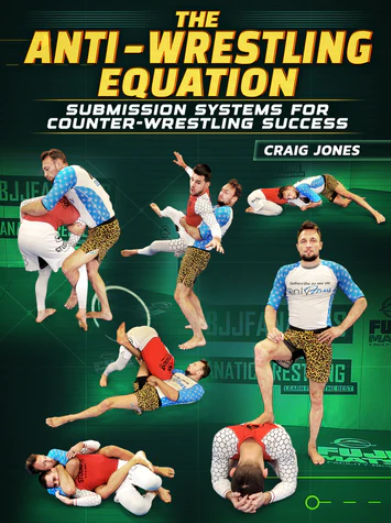Do you have trouble with wrestlers in BJJ? Or do you want to use some wrestling techniques yourself? The anti-wrestling equation by Craig Jones teaches you how to counter wrestlers, and which parts of wrestling we can safely use for ourself. In this review I tell you what’s in this instructional and what I think about it.
| Title | The anti-wrestling equation: submission systems for counter-wrestling success |
| Instructor | Craig Jones |
| Total duration | 6 hours and 2 minutes |
| Publication year | 2021 |
| Where to buy | Here on BJJ Fanatics |
What’s the anti-wrestling equation about?
It’s about wrestle-jitsu. Let me explain what I mean.
The name of this instructional is bad because it’s honestly more about wrestling than anti-wrestling. There is definitely a lot of anti-wrestling in here (‘wrestlers do this, and you should counter them like that’, etc.). But the majority is about stealing wrestling moves and using them for jiu jitsu purposes.
In fact this instructional goes further than stealing moves. Craig Jones basically builds a new style of grappling that adapts many moves from both jiu jitsu and wrestling, with the goal to take people down, keep them down and submit them. Some of the questions that Craig answers while building this system are:
- What are the differences between wrestling and jiu jitsu?
- Why are some moves very popular in one sport, but rarely seen in the other, even though they’re legal in both?
- Which (new) wrestling inspired moves are must haves in modern grappling? (Spoiler: wrist rides, spiral rides, power nelsons, elbow passes, and many others.)
- Which wrestling moves don’t work in BJJ because they can be countered in many ways?
- Which (old school) BJJ moves don’t work if people try to stand back up? (Spoiler: all the back takes from turtle that you know.)
- How can we systematically take down athletic people that don’t want to accept bottom position, in a low effort way that leads to submission opportunities?
Also read: Top 10 Best Craig Jones Instructionals (& 6 to Avoid)
The differences between wrestling and jiu jitsu
More than anything else this instructional is about the differences between wrestling and jiu jitsu. What works in one but not the other, and why?
Craig has dozens of interesting insights. Here are some that stand out to me:
- Slams are unlikely in jiu jitsu. For many reasons. Wrestlers like them because they score 5 points. But in jiu jitsu they’re too risky. To slam someone, you have to step your legs close. This exposes you to rolling leg attacks and to a counter throw (tani otoshi). Nobody does tani otoshi in wrestling because your own back hits the floor first, which loses points in wrestling.
- The deashi is super effective in jiu jitsu. The deashi is the foot sweep from the rear body lock that Gordon Ryan uses a lot. It’s super effective because in jiu jitsu when people get into a disadvantageous position, they try to run off the mat to get a reset. This move almost doesn’t happen in wrestling because there you actually give points to your opponent if you run off the mat.
- The Anaconda choke works better in wrestling. The anaconda chokse is pretty hard to set up in jiu jitsu, especially from turtle, because jiu jitsu guys are wide on their elbows. But wrestlers often post on their hands, with their hands close together to build height. This puts their shoulders much closer to their neck, which makes the Anaconda choke a super strong option.
- Jiu jitsu guys aren’t athletic. Oof, this one hurts a little. But it’s impotant. Basically, because we all practice ‘the gentle way’, none of us ever try athletic escapes. The problem with this is that none of us ever learn to prevent and counter athletic escapes either. So when we finally face an athletic person (typicalle someone from wrestling or MMA), we have a lot of problems.

How to wrestle in jiu jitsu
A huge part of this instructional is actually about wrestling, not anti-wrestling. (This is a common theme with Craig Jones: his instructionals often cover the exact opposite of what the name is.)
This is actually one of the best wrestling instructionals I ever watched. I watch a lot of ‘wrestling for BJJ’ videos and instructionals, but in my experience it’s usually a wrestler that tries to select the wrestling techniques that best fit into jiu jitsu, rather than actually adapting the techniques to jiu jitsu.
Craig here basically shows a wrestle-jitsu game that he built from the ground up, based on his experience in training with wrestlers like Nicky Rodriguez for ADCC. It’s really much better than any other ‘wrestling for jiu jitsu’ course I ever watched.
Some of the techniques Craig Jones covers
Here I’ll share a small selection of the techniques that stand out to me from this instructional. I’m writing this half for your information, and half for myself to remember the techniques better. Note: there’s way more that Craig teaches in this instructional, the techniques below are jut a sample.
Wrestling in the open
We need to get to advantageous positions before we try to throw people. The move that works best for me personally is to get a wrist grip and throw your elbow ove the top. Once you have inside elbow position you can punch a strong underhook. From there you can go into snaps and knee taps.
Standing front headlock
The standing front headlock is very different for wrestlers and jiu jitsu guys.
Wrestlers try to build height to stand up. This makes go-behinds hard, but strangles easier. But there’s nuance to this: if someone is already in a 4 point position, it’s better to go for anaconda’s than guillotines (less risk of falling off).
Jiu jitsu guys stay on their elbows. This makes go-behinds super easy and strangles harder.
Rear body lock offense
Many techniques to take someone down from the rear body lock. in my experience the knee block kosoto works 100% of the time against pure jiu jitsu guys. This gets people to put their hands to the mat, putting them in a 4 point position.

How to break down a 4 point from the back
The key is to not let the hands and feet come close to each other. That’s why you have to put shoulder pressure into the shoulders and use your knee to block their leg from coming closer. To force them down, you step on their near foot and yank their hips towards you. This puts theim either to a hip or to turtle.

How to break down a turtle
Stay behind the arms (don’t get a seatbelt yet). Get a wrist ride and a crab hook to prevent them from building a base. Get a hip grip and pull him to a hip. You’re allowed to let the wrist grip go if you need to. Once you get him to a hip you can take a seatbelt and look to take the back in various ways.
How to finish from the back
It’s nice that this part is in here because the whole instructional leads you to taking the back, and Craig actually doesn’t teach his back attack system anywhere else. I think Craig’s system is pretty similar to how most other guys do it nowadays (especially Danaher and his students), but I still picked up a few new things. For example, to finish the strangle when you’re on the underhook side, Craig uses a cool mini kimura with his underhook arm to sit his opponent up, which creates space to get your secondary arm deep behind the head.
My experience with this instructional
My experience with the anti-wrestling equation is extremely positive.
First of all, because I’m a martial arts nerd, and I love hearing about the differences between jiu jitsu and wrestling. Literally every section Craig explains something like ‘this is why they do this in wrestling, but it doesn’t work in jiu jitsu’ or the other way around.
Ok I’ll share one more example that I like. Wrestlers often defend the rear body lock by leaning back hard and squatting down to clear the body lock. But in jiu jitsu if you did this, the other guy would literally just sit down and put his crab hooks in and take your back. That’s why in jiu jitsu we can’t squat down from the rear body lock. (See the images below for an illustration.)
Second of all, the techniques work super well for me. The wrestling techniques in the open work well. The system for breaking someone down from a rear body lock to a 4 point to a turtle to a hip to a back take… It’s super easy to do, costs very little effor, I love it. (Keep in mind that I don’t typically roll with super high level wrestlers, in which case it’s probably a lot harder.)
My verdict
I highly recommend this instructional if you belong to one of 3 categories:
- You want to improve your standup and takedowns. As I explained, the name ‘Anti-wrestling equation’ is really bad, because it’s more about offensive wrestling than defensive wrestling.
- You want to counter wrestlers. Despire what I just said, there’s also quite a bit of anti-wrestling in here. Craig shows how to counter their most common movement patterns and exploit the holes in their games.
- You are a wrestler. I think this instructional will also clarify a lot of things for wrestlers. You may have found that some of your favorite moves from wrestling don’t actually lead to good positions in jiu jitsu. I think Craig Jones explains very well how you should adapt your game to make it highly effective in a jiu jitsu ruleset.
Again, I mostly belong to the first category here. And this has by far been the most beneficial instructional for my standup I ever watched. (And I watched many.)


